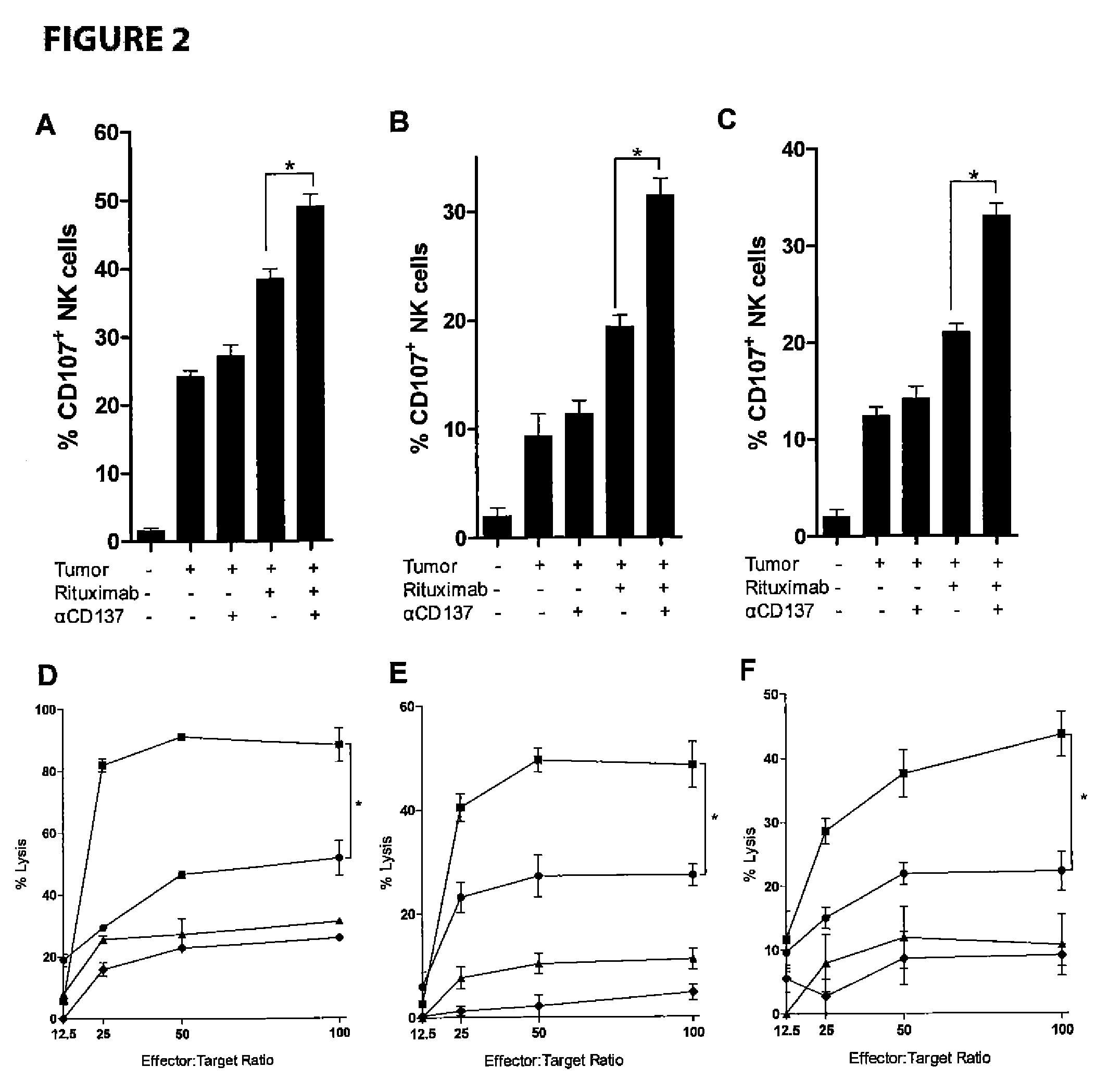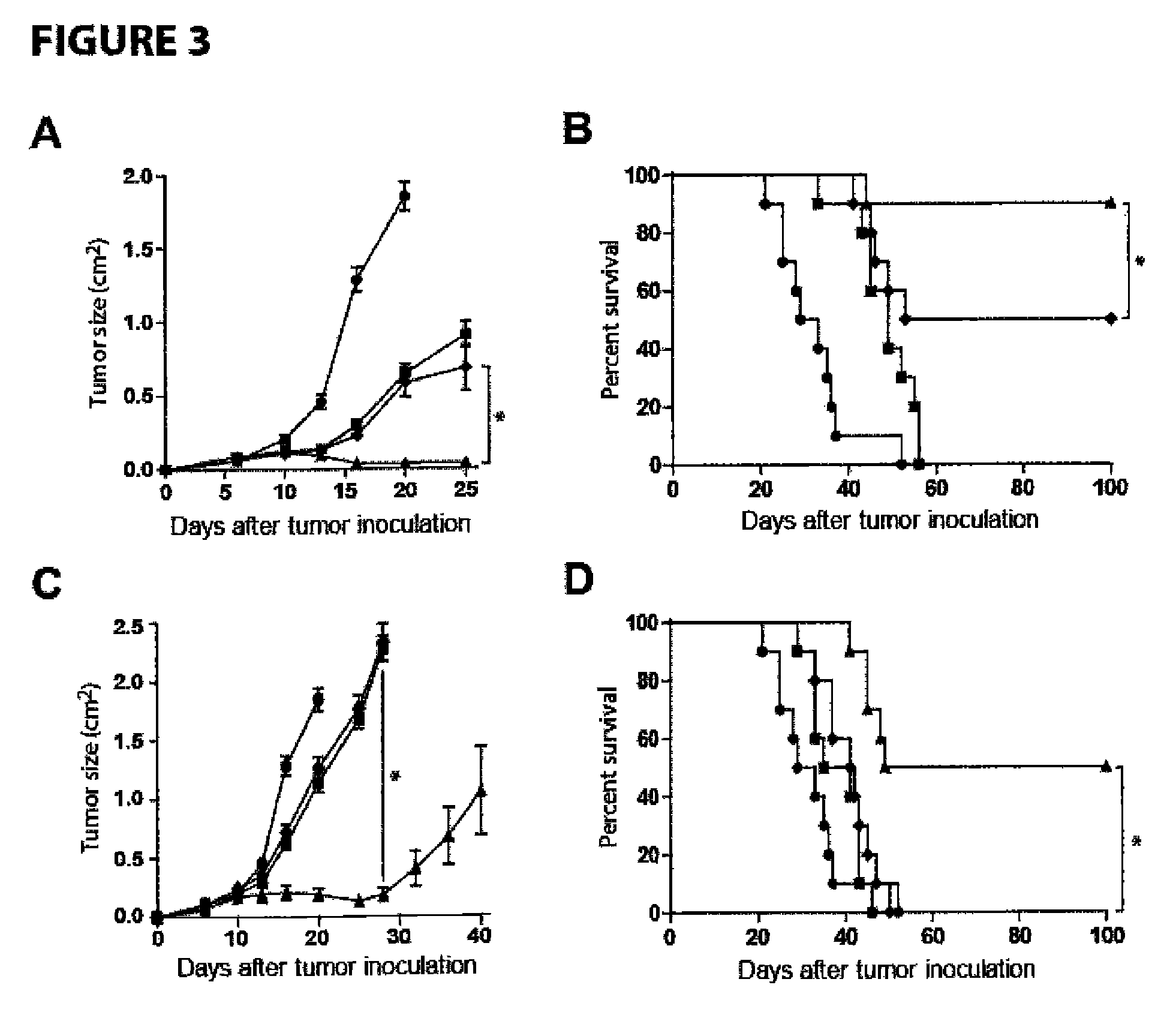Methods for enhancing anti-tumor antibody therapy
a technology of anti-tumor antibody and anti-tumor antibody, which is applied in the field of enhancement of anti-tumor antibody therapy, can solve problems such as reducing the efficacy of adcc, and achieve the effect of enhancing the anti-tumor effect of monoclonal antibodies and enhancing target cell killing
- Summary
- Abstract
- Description
- Claims
- Application Information
AI Technical Summary
Benefits of technology
Problems solved by technology
Method used
Image
Examples
example 1
[0078]Increased NK cell expression of CD137 occurs following NK cell exposure to CD20+ lymphoma coated with rituximab. Targeting CD137 with an agonistic antibody to enhance antitumor ADCC is dependent upon its increased surface expression on NK cells following their exposure to antibody coated tumor cells. Because the second antibody targets a costimulatory molecule (CD137) which is inducibly expressed on NK cells by the tumor-directed antibody (rituximab, trastuzumab), this methods allows specific stimulation of NK cells which are implicated in ADCC-mediated killing of the tumor cells (lymphoma, breast cancer), while sparing other NK cells, thereby limiting potential non specific side effects.
[0079]We isolated peripheral blood mononuclear cells (PBMCs) from patients with circulating CD20+ tumor cells due to chronic lymphocytic leukemia (CLL), marginal zone lymphoma (MZL), and CD20+ acute lymphoblastic leukemia (ALL). PBMCs were analyzed by flow cytometry after culture with trastuzu...
example 2
[0086]Increased NK cell expression of CD137 occurs following NK cell exposure to HER2+ breast cancer coated with trastuzumab. We then determined if expression of CD137 is similarly increased on NK cells following their exposure to breast cancer coated with trastuzumab. We isolated NK cells from blood of healthy donors and added them to breast cancer cell lines including MCF7 (a non-HER2 expressing breast cancer cell line) and SKBR3 (a HER2 overexpressing breast cancer cell line) for 24 hours together with trastuzumab or rituximab. The NK cells were then analyzed by flow cytometry for CD137 expression, shown in FIG. 11.
[0087]NK cell expression of CD137 was determined following co-culture with appropriate tumor cell lines coated with cetuximab (10 μg / mL), rituximab (10 μg / mL) or trastuzumab (10 μg / mL) as detailed above for breast cancer cell lines. Flow cytometry for CD3 and CD56 was performed to evaluate purity of the NK cell isolation. Additional markers of activation including CD69...
example 3
[0093]Cetuximab induces CD137 upregulation on human NK cells following incubation with EGFR-positive tumor cells, as shown in FIGS. 17A-17B. Peripheral blood from three healthy donors was analyzed for CD137 expression on CD3−CD56+ NK cells after 24 hour culture with head and neck cancer cell lines and media alone, rituximab or cetuximab, and shown to have increased expression.
[0094]As shown in FIGS. 18A-18C, anti-CD137 agonistic mAb increases cetuximab-mediated NK cell cytotoxicity on tumor cells as assayed by cell viability. Preactivated NK cells were purified before being incubated with SCC6, PC1, and SCC4 for 24 hours. The percent of apoptotic target cells was determined by annexin and 7AAD viability staining after culture with tumor alone or tumor and NK cells with media, cetuximab, anti-CD137, cetuximab and anti-CD137 antibodies.
[0095]Anti-CD137 agonistic mAb increases cetuximab-mediated NK cell cytotoxicity on tumor cells as assayed by chromium release. NK cell cytotoxicity on...
PUM
| Property | Measurement | Unit |
|---|---|---|
| time | aaaaa | aaaaa |
| time | aaaaa | aaaaa |
| time | aaaaa | aaaaa |
Abstract
Description
Claims
Application Information
 Login to View More
Login to View More - R&D
- Intellectual Property
- Life Sciences
- Materials
- Tech Scout
- Unparalleled Data Quality
- Higher Quality Content
- 60% Fewer Hallucinations
Browse by: Latest US Patents, China's latest patents, Technical Efficacy Thesaurus, Application Domain, Technology Topic, Popular Technical Reports.
© 2025 PatSnap. All rights reserved.Legal|Privacy policy|Modern Slavery Act Transparency Statement|Sitemap|About US| Contact US: help@patsnap.com



